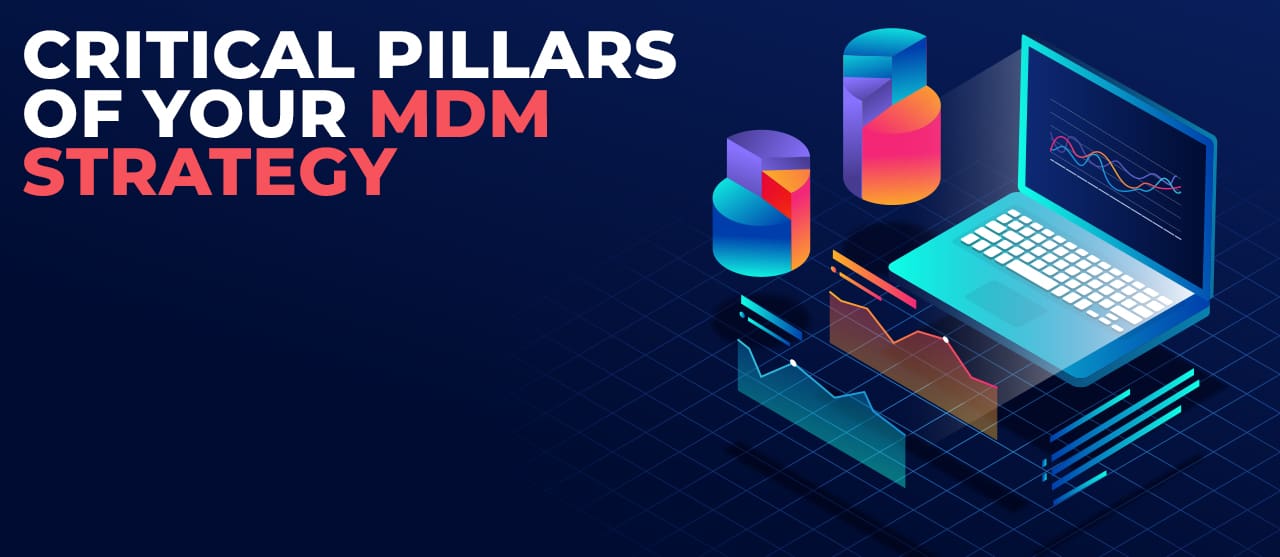
“You can have data without information, but you cannot have information without data.” –Daniel Keys Moran, American fiction writer, and programmer
According to the latest industry statistics, the total volume of data created, copied, and consumed around the globe is projected to reach 180 Zettabytes by the year 2025. Global businesses, that have invested in enterprise applications and systems (like ERP or CRM) are focusing on gaining valuable insights to make intelligent business decisions and meet market demands.
That said, most of the data that can help businesses is disorganized and unstructured. As a result, it cannot be leveraged to develop and refine business plans and strategies. To be useful, this vast amount of disorganized data needs to be transformed into relevant and accurate information. This activity comes under the purview of master data management (MDM) with the ultimate goal of enabling every department to access data and use it to their benefit.
So, what is master data management? – and how does MDM work?
What is Master Data Management?
Simply put, master data is any dataset that is collected and shared by multiple applications within an organization. For example, master data could include items like customer records, product information, employee records, and organizational assets.
So, what is MDM? To quote one industry leader, Gartner defines MDM as “a technology-enabled discipline in which business and IT work together to ensure the uniformity, accuracy, stewardship, consistency, and accountability of the enterprise’s official shared master data assets.”
What are the Primary Benefits of an Effective MDM Strategy?
Although there are many benefits of MDM, we’ll focus on four of the most common:
- Eliminating the “Noise” of Retaining Bad or Useless Data
With the right MDM strategy, enterprises can streamline data stored in different locations and formats. This helps eliminate irrelevant or outdated data and retain usable and high-quality data, resulting in better, cleaner decision-making and more confident action.
- Time and Cost Reduction
With increasing data volumes, manual processes are no longer sufficient for managing master data. An effective MDM strategy and process automates core data management processes, which saves time and reduces the cost of labor-intensive manual processes.
- Ensuring You Have the Right Data Tied to Desired Outcomes
In addition to eliminating irrelevant and inconsistent data, master data management ensures that your processes are focused on data aligned to specific decisions and actions that lead to desired business outcomes.
- Mitigating the Risk of Duplicate or Conflicting Data
Decentralized systems or applications produce duplicate and often conflicting data, which is challenging to manage and can cause business process errors. Using a centralized approach and a single data source, MDM prevents such duplication as well as the associated business risks.
There is a lot more MDM can offer that can transform how an organization deals with data such as better data compliance, easier data edits, and more. To maximize their benefits, data-driven businesses must have a robust MDM strategy.
6 Pillars of Effective MDM Strategy
1. Governance
After defining the business problem, governance is the first step when developing an effective MDM strategy. Simply put, governance is the process of bringing together all of the stakeholders to make decisions about how the master data will be used and who will have access to it. Through proper governance, enterprises can define the correct organizational roles and responsibilities for successfully implementing their MDM program.
Governance is important because it:
- Ensures that sensitive data (for example, customer data) is properly accessed, managed, and handled by the right users.
- Enables proper decision-making about master data by requiring debate and resolution by stakeholders who understand its relevance (instead of decisions being made in isolation by any one department).
- Streamlines the data management process to minimize any data-related issues.
2. Organization
The organization is a continuation of governance, as it enlists all the identified stakeholders and designates them as responsible or accountable for specific data management tasks. While governance defines the user roles of your MDM program, an organization is about managing the data ownership and stewardship that are foundational for the success of your MDM strategy.
The organization is important in MDM because it:
- Ensures that the right data stewards are setting the tone for the MDM program.
- Identifies the right stakeholders and outlines their responsibilities at the outset.
Ensures clean and accurate data with seamless access for users.
3. Process
After establishing your team, roles, and responsibilities, the next step is to focus on your enterprise-wide processes. One major responsibility of the MDM governance body is to evaluate existing MDM processes and then decide to make minor changes, major changes, or completely overhaul the current processes with the goal of making them more MDM compliant.
The process is important in MDM because it:
- Documents the entire data-related process for future reference.
- Highlights how data is being created and used by the enterprise.
- Enables stakeholders to agree upon necessary process changes.
4. Standards
Effective data management is not complete without defining the standards that the MDM process must follow. For instance, regulatory standards are external directives that the organization must follow while managing business data. Typically, standards are used to define a customer, or set performance benchmarks (or KPIs that can measure MDM success), or define data quality standards (for example, GDPR compliance).
Standards are important in MDM because they:
- Act as guardrails of the MDM strategy ensuring that data management doesn’t stray from its core objective.
- Safeguard compliance with all requirements related to data handling.
- Ensure adherence to regulations thus mitigating risk and avoiding penalties.
5. Technology
An MDM program cannot be successfully implemented without the right technology. Considering the massive volumes of data to be managed, organizations need technology to automate processes and manage data intelligently. Choosing the right technology is easier after you define the process and the standards.
Technology is important in MDM because it:
- Supports the requirements of every MDM team member.
- Ensures the appropriate solution, including automation, to the business problems being addressed.
6. Measurement
Measurement of your MDM program is vitally important to ensure you understand its performance and business impacts and also to identify areas for continual improvement. Using measurement, organizations can determine if their MDM strategy is achieving its desired objectives (or not). Proper measurement also helps provide guidance when making iterations to the current MDM strategy.
Measurement is important in MDM because it:
- Provides an understanding of the value of the MDM program.
- Enables adjustments to the program to ensure that it stays on the right track.
Helps determine other business aspects such as project costs and duration, along with the impact of MDM strategy on various business areas.
Conclusion
MDM has become core to the success of any data-centric organization. To ensure that business enterprises are getting the most value from MDM, they should consider all six pillars of effective MDM strategy.
At EnFuse Solutions, we have the technical expertise to collaborate with global clients and provide professional data management services to initiate and support MDM programs. Are you ready to develop an MDM strategy that works for your business? Feel free to contact us – we’re ready to help you succeed.
Leave a Reply
Your email address will not be published. Required fields are marked *


















Comment